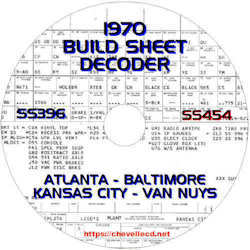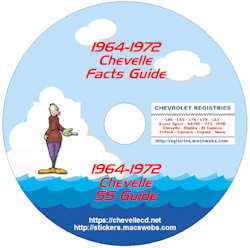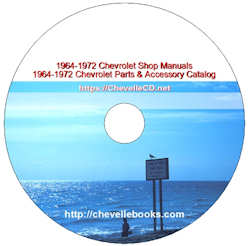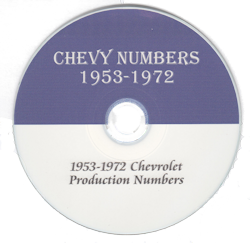Rebodied Chevelles
One BIG reason to have a potential Chevelle you are considering buying inspected by someone with intimate knowledge of your particular Chevelle is the car isn't always what it appears to be. This is especially true if you're considering that right color, right optioned Chevelle of your dreams. If you are looking to spend north of $80,000 you need to have it inspected by a reputable Chevelle 'expert.'
The 1969 and 1970 Chevelles are very popular years of SS396/SS454 Chevelles and the LS6 sits at the top of the desired list. With only 4,475 LS6 Chevelles being built, finding not only a real one but just the one that fulfills your fantasy can be a chore. Paperwork in the form of an original build sheet, original window sticker, original warranty card (Protect-O-Plate) can go a long way in proving a Chevelle's provenance. Beware of window stickers, Protect-O-Plates, and build sheets that look too good to be true - all three are often reproduced in order to 'prove' a particular car. Aftermarket window stickers are readily available from several sources but the honest ones will not try to 'weather' the sticker to make it appear original. Same for warranty cards (Protect-O-Plate) and build sheets. I have a CD program to decode 1970 Atlanta, Baltimore, Kansas City, and Van Nuys SS396/SS454 build sheets to help you spot a fake. I also have 1966-1968 Chevelle Reference CD programs, 1964-1972 Chevelle Facts Guide CD program, and a 1964-1972 SS Guide CD program, and Shop Manuals & Parts Catalog DVD program to assist you.
Another area of concern is a rebodied car; essentially a builder takes legitimate LS6 components (engine, transmission, and rear end) and puts them in a different body but also affixes the real LS6 Chevelle's Vehicle Identification Number (VIN) plate and possibly even the Fisher Body Number Plate. Laws will vary from state to state but, basically, it is illegal to swap a VIN plate from one car to another. Typically a 'hidden' VIN is found in two places on a 1970 Chevelle; on top of the frame rail generally on the driver side aft of the rear axle and stamped on the firewall behind the heater box. The engine block and transmission case is also stamped with a partial VIN (something like 10A123456). The 'hidden' VIN is also referred to as a 'Confidential VIN.' These were stamped out of normal view to assist law enforcement in tracking and locating a car whose VIN has been changed for illegal purposes. You might wish to read here about hidden VINs and rebodied cars.
A rebodied car can be difficult to spot if the person (or shop) has only swapped the body but kept and affixed the original car's VIN plate. One place to look for a hidden VIN is behind the heater box. Beginning with the 1968 model year (and 1967 for Atlanta), partial VINs were stamped on the firewall behind he header box.
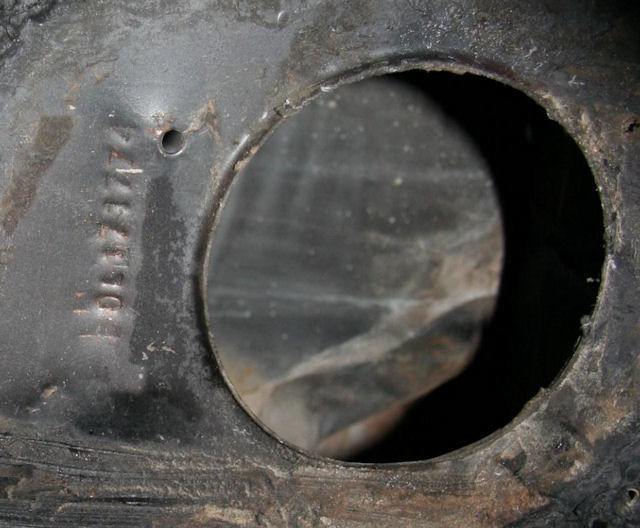
If the last six digits on the car's VIN does NOT match the last six digits found in a hidden VIN, then the car is not authentic. Even if the engine and transmission are legitimate LS5/LS6 components, if the partial VIN doesn't match the partial VIN stamped on the engine block, the car itself cannot be verified as a true LS6 car. Naturally this would hold true of any engine.
If the partial VIN stamped on the firewall and/or frame rail doesn't match the VIN plate itself, that's where the danger comes in - a legitimate VIN plate being attached to another car.
Fisher Body Number Plate
At least in the state of Oklahoma, it is also illegal to swap or alter the Fisher Body Number Plate, also know as a 'trim tag,' 'cowl tag,' etc.

https://www.oscn.net/applications/oscn/deliverdocument.asp?id=450125
Basically the Oklahoma law states it's illegal to swap, alter, or change a Fisher Body Number Plate. A reproduction can be made but must contain the verbiage 'REPLACEMENT TAG" in letters 1/8" high. Why are these important? Many Chevrolet's (and other makes) trim tags may contain information showing certain options or body modifications for desirable cars and a fake or swapped tag can greatly affect the value of a car. Even the color of the car can affect it's value if a buyer is looking for a particular color.
The first part of the Oklahoma law reads:
A. It shall be unlawful for any person to:
1. Knowingly and intentionally destroy, remove, cover, alter or deface,
or cause to be destroyed, covered, removed, altered or defaced the trim
tag plate of a motor vehicle manufactured from 1953 to 1977;
2. Knowingly affix a counterfeit trim tag plate to a motor vehicle;
3. Manufacture, offer for sale, sell, introduce, import or deliver for
sale or use in this state a counterfeit trim tag plate; or
4. Offer for sale, sell, introduce, import or deliver for sale or use
in this state a trim tag plate that was affixed to a motor vehicle at
the time of manufacture but has since been removed or become dislodged.
Federal Motor Vehicle Safety Standards Sticker
Beginning in 1969, GM introduced a Federal Motor Vehicle Safety Standards sticker affixed to the driver's door. These stickers also included the full VIN. To my knowledge it is not illegal to replace this sticker with an aftermarket unit but the car's VIN should match.
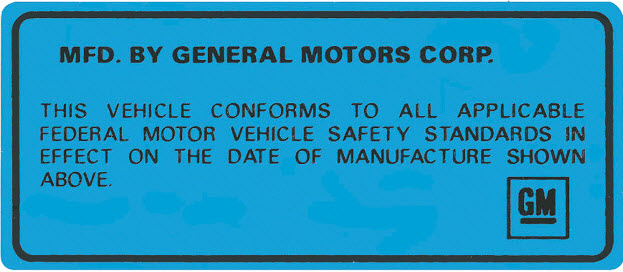
![]() Mention you saw it on © ChevelleWorld and please give the site credit for the
information.
Mention you saw it on © ChevelleWorld and please give the site credit for the
information.
![]() Be sure to visit my ChevelleCD site for
Chevelle CDs, challenge coins, and other gifts for that Chevelle fan in your
family and my
Stickers & Calendars website for custom stickers and calendars with your
favorite car/pet/occasion.
Be sure to visit my ChevelleCD site for
Chevelle CDs, challenge coins, and other gifts for that Chevelle fan in your
family and my
Stickers & Calendars website for custom stickers and calendars with your
favorite car/pet/occasion.

 1964 Chevelle
1964 Chevelle 1965 Chevelle
1965 Chevelle 1966 Chevelle
1966 Chevelle 1967 Chevelle
1967 Chevelle 1968 Chevelle
1968 Chevelle 1969 Chevelle
1969 Chevelle 1970 Chevelle
1970 Chevelle 1971 Chevelle
1971 Chevelle 1972 Chevelle
1972 Chevelle